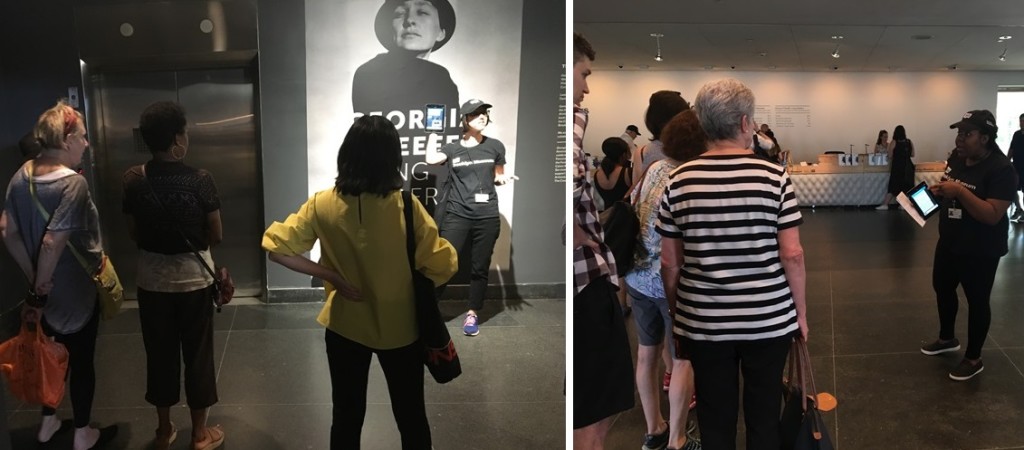Dedicated Staff Help…But It’s Not Enough
Radio silence from us usually means we’re up to something and this time is no different. Since our last post in May, we’ve been looking at data, trying out a few things, and planning some new pilot projects.
Here’s where we stand: the ASK Ambassadors, our dedicated guerrilla marketers, have been on the floor since mid-February. We’ve had a few successes thanks to their hard work. One unexpected boon is with the ASK Ambassadors doing their pitch, for the first time, users pretty much universally understand that they are chatting with a human (as opposed to a bot). One of the ways this confusion manifested was people sending us keywords instead of phrases, sentences, or questions and then often apologizing later once they figured out it was a human. ERm’s evaluation confirmed this confusion. (Side story: one focus group participant wondered aloud if he was chatting with a real person and when someone else pointed out the photo of the team, he replied that it was like a United Colors of Benetton ad; no way it was the real team and had to have been staged. Yikes.) Now, however, users are ready to jump into conversation and we’re getting a lot more people replying directly to our auto-fire system message that let’s them know we’ll get to them and to feel free to put down their phone. “OK,” they tell us. A different kind of confusion perhaps, but preferable.

ASK Ambassador floor captain, Alex, (left) loves pitching the app to folks waiting on the elevator. Kahlah (right) talks to people waiting in line at admissions.
I’m happy to report a noticeable uptick in use rate thanks to ASK Ambassador mojo. We’re regularly above our previous 1% average use rate and have even seen some weeks above 2%, which is great. But it’s not enough.
We are at the point in this project where it’s time to take stock. We’ve paved the way for what it means to engage visitors with art via text message. We know people love ASK; our app store ratings continue to be stellar. So it’s not an engagement problem. We’ve done lots of testing around messaging to highlight what’s unique about ASK, and that seems to be working pretty well. There’s more clarity for users around the experience than ever before. We’ve run contests and incentives with varying degrees of success (one in the O’Keeffe show, which we’ll blog about later). Still we struggle with use rate. It’s time to admit fully and completely that the thing that stands in our way is the fact that ASK is an app. ERm’s evaluation told us this and our own experience echoes this truth. We’re seeing across the industry that people don’t want to download apps. Colleen Dilenschneider has pulled together some great research on this. It’s somewhat heartening to know that we’re not alone in the struggle, but frustrating if you, like us, have built an app!
So now, what? As I hinted at the beginning of this post, we’re running a series of pilot tests to figure out our next move. Two of the pilots focus on removing the app format as a barrier and the third focuses on heightening the motivation and value-add factor of downloading. The pilots will take a total of six weeks, two weeks for each, and we’ll know a lot more at the end of this journey.
For the first pilot, which finished last week, we offered visitors iPods loaded with the app. They were free for check-out the first week, available for a rental fee of $5 the second week. I must say, I was surprised by the results…which I’ll share next week in the first of our series of posts about the pilots. Stay tuned.

Sara Devine joined the Brooklyn Museum as Manager of Interpretive Materials in 2011 and is now Director of Visitor Experience & Engagement. A vocal visitor advocate, her expertise lies in crafting accessible and engaging visitor experiences and reaching audiences across platforms. She works with curators, designers, educators, technologists, and editors on all aspects of visitor experience and engagement. Sara is also a visiting assistant professor and curriculum coordinator at Pratt Institute’s School of Information for their graduate program in Museums and Digital Culture. She was previously Senior Content Developer and Project Manager at Hilferty, a museum planning and design firm in Ohio, where she developed comprehensive interpretive master plans and exhibitions for a wide variety of museums. She has also worked at Assistant Curator, Special Exhibition at Thomas Jefferson’s Monticello and as a Curatorial Assistant at the Smithsonian Museum of Natural History.


Start the conversation